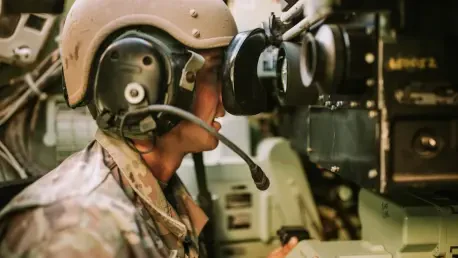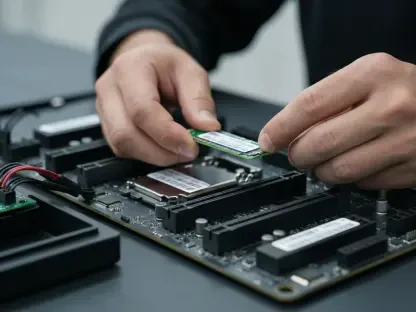In an ambitious bid to modernize its communication infrastructure, the U.S. Army is considering moving away from traditional radios for tactical communication and data transmission at the tactical edge. Instead, the Army envisions utilizing Android end user devices, currently provided to team leaders, which would be strapped to soldiers’ chests. These devices would not only feature position and location information but also enable communication through emerging voice-over-IP technology. This significant shift in strategy aims to streamline communication processes and reduce the equipment load on soldiers.
Next Generation Command and Control Initiative
Clean-Slate Methodology and Agile Architectures
The Army’s initiative, known as Next Generation Command and Control (NGC2), represents a profound change from the traditional approach to military communications. This project embraces a clean-slate methodology aiming to modernize communication and command structures. Focusing primarily on agile, software-based architectures, NGC2 seeks to facilitate the seamless flow of information and enhance command control capabilities. The modernized system has already undergone rigorous testing at Project Convergence, held at Fort Irwin, California.
Gen. James Mingus, Army vice chief of staff, has articulated the primary goal of this initiative: to simplify the equipment load for soldiers by consolidating multiple communication devices into a single unit. This ambitious modernization effort targets communication capabilities at the tactical level, specifically for the battalion and below, while higher echelons will continue to rely on traditional radios due to their need for larger data transmission capabilities. This ensures that while frontline soldiers benefit from streamlined equipment, strategic levels maintain robust and expansive communication channels.
Portable Signal Transmitters and Network Architecture
Supporting the shift towards advanced end user devices is an updated network architecture that leverages portable signal transmitters colloquially referred to as “pucks on trucks.” These devices are designed to move radio frequency signals effectively across the battlefield. By establishing terrestrial-based mesh networks, these transmitters facilitate long-range communications and maintain seamless connectivity with the end user devices. The integration of such technology promises to transform battlefield communication dynamics, providing a flexible and resilient network structure that adapts to real-time needs.
The new architecture enhances the operational effectiveness of military communication systems. It minimizes the dependency on static communication infrastructure, thereby increasing mobility and reducing vulnerabilities. The mesh network capability enabled by “pucks on trucks” ensures that communication lines remain open and operational, even in challenging and rapidly changing environments. This innovative approach exemplifies the Army’s commitment to leveraging cutting-edge technology to achieve strategic and tactical advantages.
Emerging Controversies and Concerns
Risks of Reduced Communication Diversity
Despite the clear advancements presented by the NGC2 initiative, its implementation has sparked controversy among various industry stakeholders. A primary concern is the potential risk associated with reducing the diversity of communication tools. Experts argue that relying solely on voice-over-IP, WiFi, or 5G technologies might not offer the necessary redundancy critical in scenarios where adversaries might attempt to jam or disrupt communications. This principle, known as PACE (primary, alternate, contingency, emergency), underscores the need for multiple layers of communication methods to ensure reliability and efficacy.
The debate centers around the balance between technological innovation and operational resilience. While end user devices equipped with push-to-talk features promise enhanced capabilities, military communication experts assert the importance of maintaining a mix of communication tools, including traditional radios. Such diversity is perceived as essential to ensure flexible and resilient networks that can adapt to and withstand diverse operational challenges. In high-stakes environments, the failure of critical communication systems could jeopardize mission success and soldier safety.
Ensuring Operational Effectiveness
Maintaining a diverse array of communication tools is seen as vital to operational effectiveness. Redundancy in communication systems ensures that if one method fails or is compromised, alternative channels remain available to guarantee continuous communication. This approach aligns with military doctrines that prioritize preparedness and adaptability in unpredictable and hostile environments. The integration of traditional radios alongside advanced end user devices embodies a balanced architecture that can support mission success under varied operational conditions.
Experts continue to advocate for a cautious approach to the full-scale adoption of voice-over-IP technology in military operations. They emphasize the need for comprehensive testing and evaluation to identify potential vulnerabilities and develop strategies to mitigate them. The overarching goal is to harness the benefits of modern technology while preserving the security and reliability of military communication networks. Striking the right balance between innovation and resilience is critical to ensuring that soldiers remain connected and informed, regardless of the operational context.
Conclusion: A Balanced Path Forward
The U.S. Army is embarking on an ambitious plan to modernize its communication infrastructure, considering a move away from the traditional radios historically used for tactical communication and data transmission at the tactical edge. This strategic shift envisions the use of Android end user devices, which are already being provided to team leaders. These devices are intended to be worn on soldiers’ chests, merging several functionalities into one compact unit. Not only will these devices provide crucial position and location information, but they will also facilitate communication through advanced voice-over-IP technology. The overarching goal of this new strategy is to streamline communication processes, increase efficiency, and lighten the equipment load that soldiers have to carry. By implementing these changes, the Army aims to enhance the agility and effectiveness of its forces on the ground. This transition reflects a significant modernization effort, integrating cutting-edge technology to improve operational capabilities and overall mission success.









